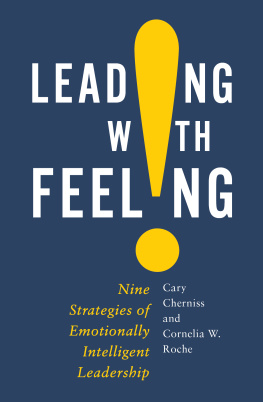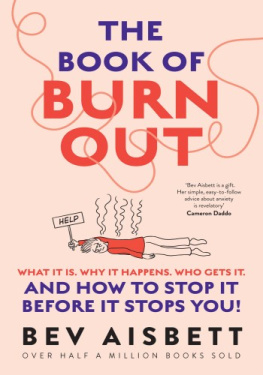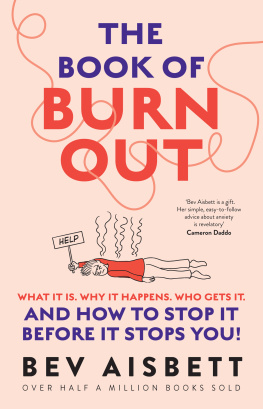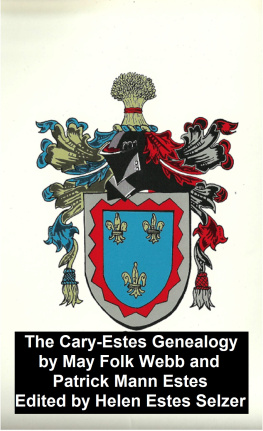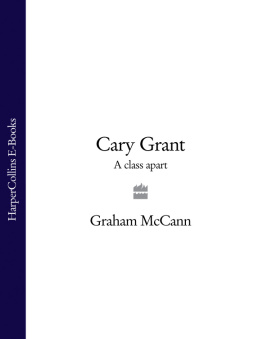Beyond Burnout
Beyond Burnout
Helping Teachers,
Nurses, Therapists,
and Lawyers
Recover from Stress
and Disillusionment
Cary Cherniss
First published 1995 by Routledge
Published 2016 by Routledge
2 Park Square, Milton Park, Abingdon, Oxon OX14 4RN
711 Third Avenue, New York, NY 10017, USA
Routledge is an imprint of the Taylor & Francis Group, an informa business
Copyright 1995 by Cary Cherniss
All rights reserved. No part of this book may be reprinted or reproduced or utilised in any form or by any electronic, mechanical, or other means, now known or hereafter invented, including photocopying and recording, or in any information storage or retrieval system, without permission in writing from the publishers.
Notice:
Product or corporate names may be trademarks or registered trademarks, and are used only for identification and explanation without intent to infringe.
Credits and acknowledgments borrowed from other sources and reproduced, with permission, in this textbook appear on appropriate page within text.
ISBN: 9780415912051 (hbk)
ISBN: 9780415912068 (pbk)
Library of Congress Cataloging-in-Publication Data
Cherniss, Cary.
Beyond burnout : helping teachers, nurses, therapists, and lawyers recover from stress and disillusionment / by Cary Cherniss.
p. cm.
Includes bibliographical references (p.) and index.
ISBN 978-0-415-91205-1 ISBN 978-0-415-91206-8 (pbk)
1. Burn out [Psychology) 2. lob stress. 3. Stress management. 4. Stress managementcase studies. 5. Stress (Psychology) I. Title.
BF481C45 1995
To Deborah, who has taught meand many others 50 much about caring and compassion.
And to all the professional caregivers who struggle valiantly to keep their idealism.
Contents
Antidotes to Burnout:
Finding Greater Professional Autonomy and Support
Antidotes to Burnout:
What the Individual Brings to the Work
This book is about a group of people who became human service professionals. They were poverty lawyers, public health nurses, high school teachers, social workers, and psychologists. They wanted to serve others, and they began their careers with enthusiasm and commitment, caring and compassion.
I originally studied these professionals during their first year of practice. Using in-depth interviews, I learned about the stresses they experienced as their idealism collided with the realities of public schools, legal aid clinics, and mental health centers. I witnessed how, in response to these stresses, they lost much of their idealism and commitment. The study became an examination of early career burnout.
Ten years later I decided to track down all of those professionals to see what had become of them. Had any of them regained their idealism? Had they remained in public service? What effect had a growing social conservatism in the country had on their outlooks and actions? This book is about these two studies.
In the summarize what I learned in the initial study and indicate what the professionals were like when I left them at the end of their first year of practice.
I examine how their careers evolved. Some had remained in public service while others had gone into private practice; some continued to work as helping professionals while others had made radical career changes. I describe the different career paths that they took.
The next four chapters explore how the professionals attitudes and values changed. In of the book with a look at how the professionals felt about their lives as they moved into the second decade of their careers.
describes five professionals who initially were among the most stressed and burned out, but who managed to recover. By the time of the follow-up study, they were among the most committed, compassionate, and satisfied.
switches the focus to the individual, noting the personal characteristics that helped some to sustain commitment and caring for a decade or more.
is the most practical in the book. I identify seven implications for public policy and practice that come out of the preceding chapters. I suggest how professional caring and commitment can be enhanced through changes in selection and training of professionals and management of human service programs.
The concludes with one more implication for policy and practice.
Writing the acknowledgments for a book is a bit like preparing the guest List for a partyit is so easy to leave out someone who should be included. Thus, with some trepidation, I would like to thank all those who have helped me with this book, including those whom I neglect to mention by name. One especially important group that must remain nameless is the group of 25 professionals who participated in the study. They offered not only their time but also their words and insights. The best in this book came from them.
I would also like to thank the many students at both the University of Michigan and Rutgers University who helped with the research, especially Sally Wacker, Ed Egnatios, Bill ODowd, Bette Clark, Casey Kelliher, Kerry Klett, and Charles Reid.
Carole Herscheit and Laurie Lavine also assisted with the research. Laura Spitz Segal patiently typed the transcripts for the first study. Barb Strane and Judy Cox helped me track down the subiects for the follow-up study.
My colleagues at the Graduate School of Applied and Professional Psychology at Rutgers have supported and inspired me in many ways. I am particularly indebted to Dan Fishman, Lew Gantwerk, Sandra Harris, Milt Schwebel, and Alan Wiesenfeld for their guidance and suggestions along the way. I also appreciate the support I have had from my editor at Routledge, Philip Rappaport, who has always been ready to listen to my questions and find the answers.
Funding for the research on which the book is based came from Rutgers University and from the National Institute of Mental Health (Grant PHS MH 4245701).
Seymour B. Sarason has contributed to this work in numerous ways, including the most important. He continues to be a source of inspiration as a teacher, mentor, and friend. Id also like to recognize the contributions of my son, Joshua L. Cherniss, who has encouraged me through his example as well as through his words, and who also helped with the editing of .
Finally, I thank my wife, Deborah Cherniss, who has helped in so many different ways, both tangible and intangible. She typed hundreds of pages of transcripts, she edited every page of the manuscript more than once, she offered suggestions and support whenever needed, and, most important, she always had faith in me and in this project. In my own life, she has been the best model of a compassionate helper I have ever encountered.
Each year thousands of people enter one of the helping professions in order to serve others. What they do affects how we live, how we feel, even what we become, and their impact on our lives has been growing.
Professionals have always been important for the public welfare. One author called them the agents by which society dealt with its major problems (Schein, 1972, p. 2). In the last century, however, the professions have become even more significant. Just in sheer numbers, the proportion of professionals in the population has grown enormously. In 1890, 3.8 percent of the adult population were professionals; in the next thirty years it rose slightly to 4.4 percent; but in the next 40 years, the percentage nearly tripled. In 1960 professionals constituted 13 percent of the adult population (Veysey, 1975).



